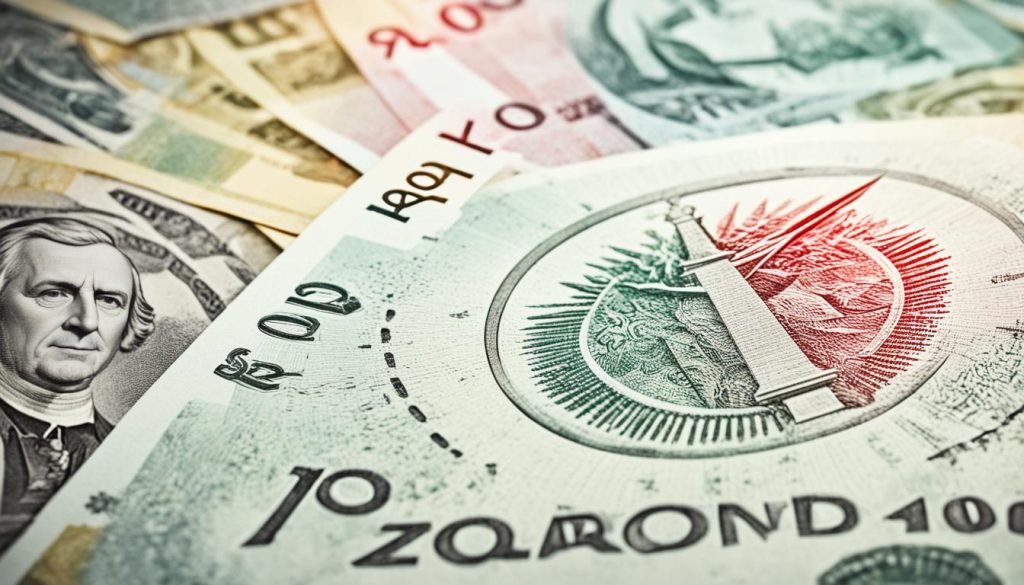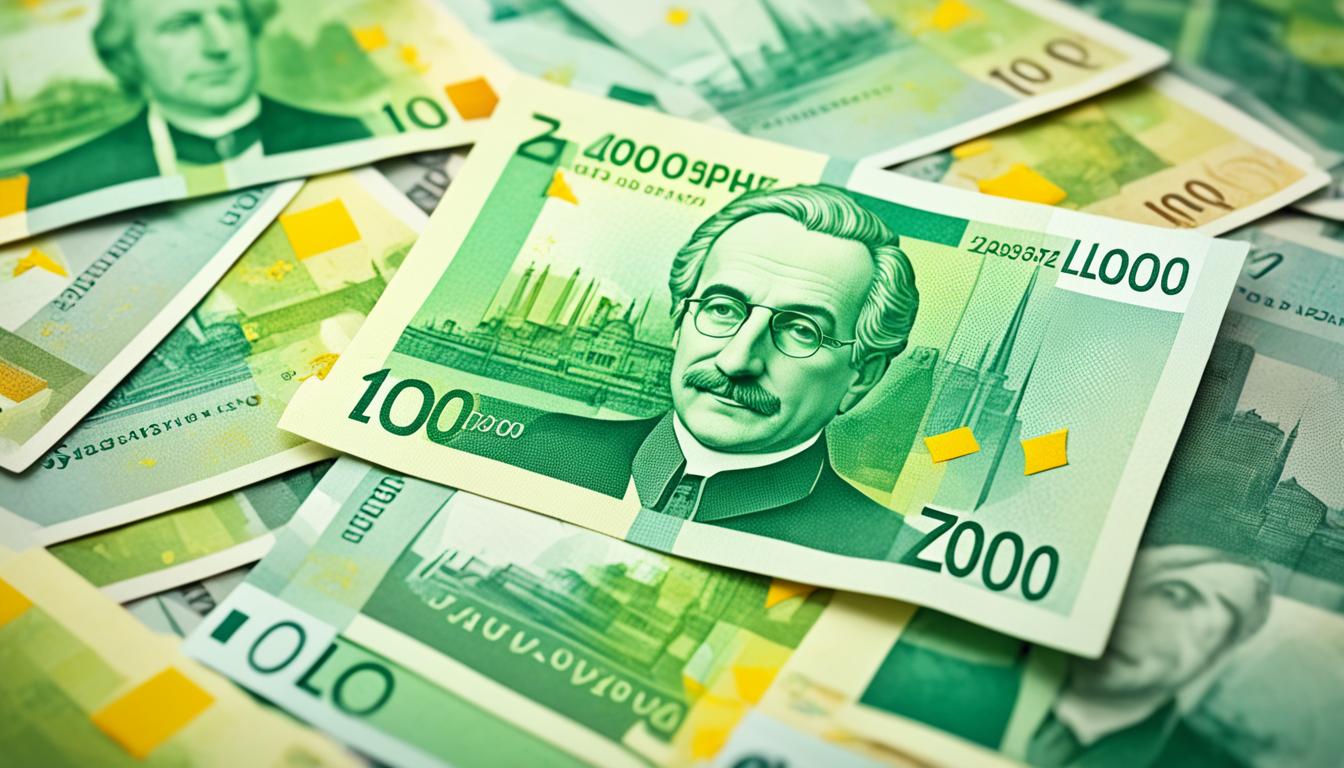The Polish currency, known as the zloty, is crucial to the country’s economy. It’s vital to know about the zloty’s exchange rate to understand its global value. The term ‘zloty’ means ‘golden’, showing its importance in Poland’s economy and identity. This piece will explore the zloty’s role, history, and impact both in Poland and worldwide.
Key Takeaways
- The zloty remains the cornerstone of the currency in Poland, holding substantial sway over the national economy.
- An understanding of the zloty exchange rate is indispensable for an accurate assessment of Poland’s economic vigour.
- The denomination and value of Polish currency is a direct reflection of the country’s financial health.
- Changes in the Polish zloty value resonate through Poland’s market stability and international trade relations.
- Keeping abreast of the economic system of Poland involves a thorough analysis of the zloty’s performance.
- The monetary unit of Poland, steeped in history and culture, continues to evolve alongside the country’s economy.
Introduction to the Zloty: Poland’s National Currency
The Polish zloty, standing as the testament of the nation’s rich economic tapestry, embodies a history replete with transformative events and an enduring legacy. As we delve into the aspects that craft its identity, we uncover the thread that weaves the past into the present of Poland’s monetary system. Here, we explore not only the evolution of the zloty but also the contemporary prowess of its security features and cultural embodiment in the design.
Origins and History of the Zloty
Rooted in the word that means ‘golden’, the zloty’s history tracks back to the Middle Ages. It became an essential part of Poland’s money system. Over centuries, it faced ups and downs, shaped by government rules. This currency journeyed through divisions, conflicts, and a fresh start, symbolising national unity.
Looking at zloty coins and notes shows many changes due to economy and politics. From Ducats to banknotes in the 1800s, every period added something new to the zloty.
Current Currency Design and Features
The modern Polish currency design is a proud show of national heritage. It features important people and places on banknotes, enhancing cultural pride. Zloty coins and notes aren’t just for buying things. They also tell stories of Poland’s notable achievements and dreams.
Keeping the zloty safe and real is crucial. Thus, Poland uses high-tech security in its money. The National Bank of Poland keeps adding features like watermarks and special prints to fight fakes. They’re dedicated to make the zloty secure and trusted.
| Denomination | Historical Figure | Landmark | Security Feature |
|---|---|---|---|
| 20 PLN | King Bolesław I the Brave | The Royal Castle in Warsaw | Colour-shifting ink |
| 50 PLN | King Casimir III the Great | The Wawel Castle | Watermark with light-variable elements |
| 100 PLN | King Władysław II Jagiełło | The Battle of Grunwald monument | See-through register |
| 200 PLN | King Sigismund I the Old | The Sigismund’s Chapel | Microlettering |
Today, the zloty’s story goes on with every payment, mixing Poland’s varied history and its current economic dreams. The ongoing change in the zloty keeps it strong, honours its past, and looks forward to new financial ideas.
The Economic Role of the Currency of Poland
The zloty’s economic impact on Poland’s trade and financial stability is huge. It helps a lot with trade. It’s closely tied to the Polish fiscal policy. This policy sets its value both at home and abroad. A stable currency attracts foreign investment. This is good for the economy and growth in Poland.

We must look at the zloty’s buying power to understand Poland’s financial stability. This power affects people, businesses, and the wider economy. It changes inflation and how much things cost compared to other countries. Also, the value of the zloty changes Poland’s GDP a lot. This affects the government’s money plans and economic strategies.
| Year | GDP of Poland (in billions) | Average Exchange Rate (zloty to USD) | Inflation Rate (%) |
|---|---|---|---|
| 2020 | 594.20 | 3.91 | 3.4 |
| 2021 | 642.10 | 3.89 | 5.1 |
| 2022 | Estimated Growth | Varies | Estimated Increase |
Polish fiscal policies greatly impact the zloty’s value. They find a balance between building economic strength and meeting global challenges. According to the Polish Ministry of Finance, these policies are vital. They use the zloty to meet national economic goals.
“A nation’s currency is its global business card,” – as often noted by economists, the zloty not only cements the economic sovereignty of Poland but is also emblematic of its potential and prosperity.
- Fiscal policies driving economic indicators
- Trade balance and its implications on currency value
- Influence of global market dynamics on zloty stability
Exchange Rates and International Considerations
The zloty exchange rate trends are crucial for international trade in Poland. They show Poland’s economy health and how investors view Polish assets.
Factors Influencing the Zloty Exchange Rate
Many factors impact the zloty’s value. A key factor is Poland’s trade balance. A positive balance means exports are higher than imports, making the zloty strong. But, a trade deficit weakens the zloty.
Interest rates in Poland also affect the zloty. High rates attract investors, raising its value. Global events and policies add to the currency’s ups and downs, affecting investor choices.
Understanding the Impact of Currency Fluctuation on Trade
Changes in the zloty’s value alter Poland’s trade balance. A strong zloty makes Polish goods expensive abroad, hurting exports. A weak zloty, however, makes them cheaper and boosts exports.
Currency exchange forecasts are vital for international businesses. They help protect against currency value shifts, keeping profits stable. Polish experts watch these trends closely to guide economic decisions.
Conclusion
The Polish currency’s journey is rich and full of importance. Its history, design, and use show Poland’s big mark on the world. The story of Polish currency is more than just money. It’s about Poland’s past and smart money ideas.
The zloty has always been key to Poland’s economy. Looking ahead, Poland’s economy and the zloty will face new global challenges. The future of the zloty will need smart plans and strong policies. Poland’s National Bank and economists are ready for this future.
The zloty shows Poland’s constant aim for stability in a changing world. As global economics change, the zloty’s ability to adapt will be crucial. It shows Poland’s cleverness and strength. The zloty is not just for trade. It’s a symbol of national progress and Poland’s hopes in the global economy.
FAQ
What is the currency used in Poland?
The Polish zloty is Poland’s currency. It is vital for the country’s economy.
Can you provide a brief history of Polish currency?
Polish currency history reaches back to the Middle Ages. Through time, the zloty has changed due to reforms and economic shifts.
What are the denominations and security features of the zloty?
The zloty comes in various coins and notes, all with special security. They have watermarks, threads, and holograms to fight fakes.
How does the zloty exchange rate impact Poland’s economy?
The zloty’s rate affects financial health and trade in Poland. Rate changes can influence import and export prices, shaping the economy.
What role does the Polish zloty play in the national economy?
The zloty helps in trade and values goods. It’s key for economic strength, affects buying power, and matters for Poland’s GDP.
What factors influence the value of the Polish zloty on the international market?
The zloty’s international value changes with Poland’s trade, interest rates, global events, and economic trends.
How is the zloty’s value important for Polish businesses and consumers?
The zloty decides how much things cost in Poland. It affects prices and living costs, important for businesses and people.
What security measures are in place for zloty coins and banknotes?
Zloty money uses modern security to prevent fakes. This includes special inks and features hard to copy.
What are the latest trends in the zloty exchange rate?
Zloty rates change with world events, economic news, and market guesses. Experts try to predict these moves.
How might future fiscal policies affect the Polish zloty?
New policies could change the zloty’s value. This might involve interest rates, controlling inflation, or promoting growth to adjust demand.



